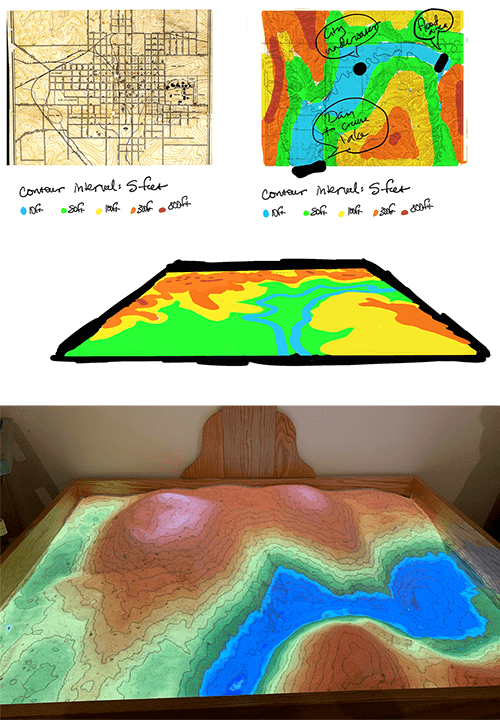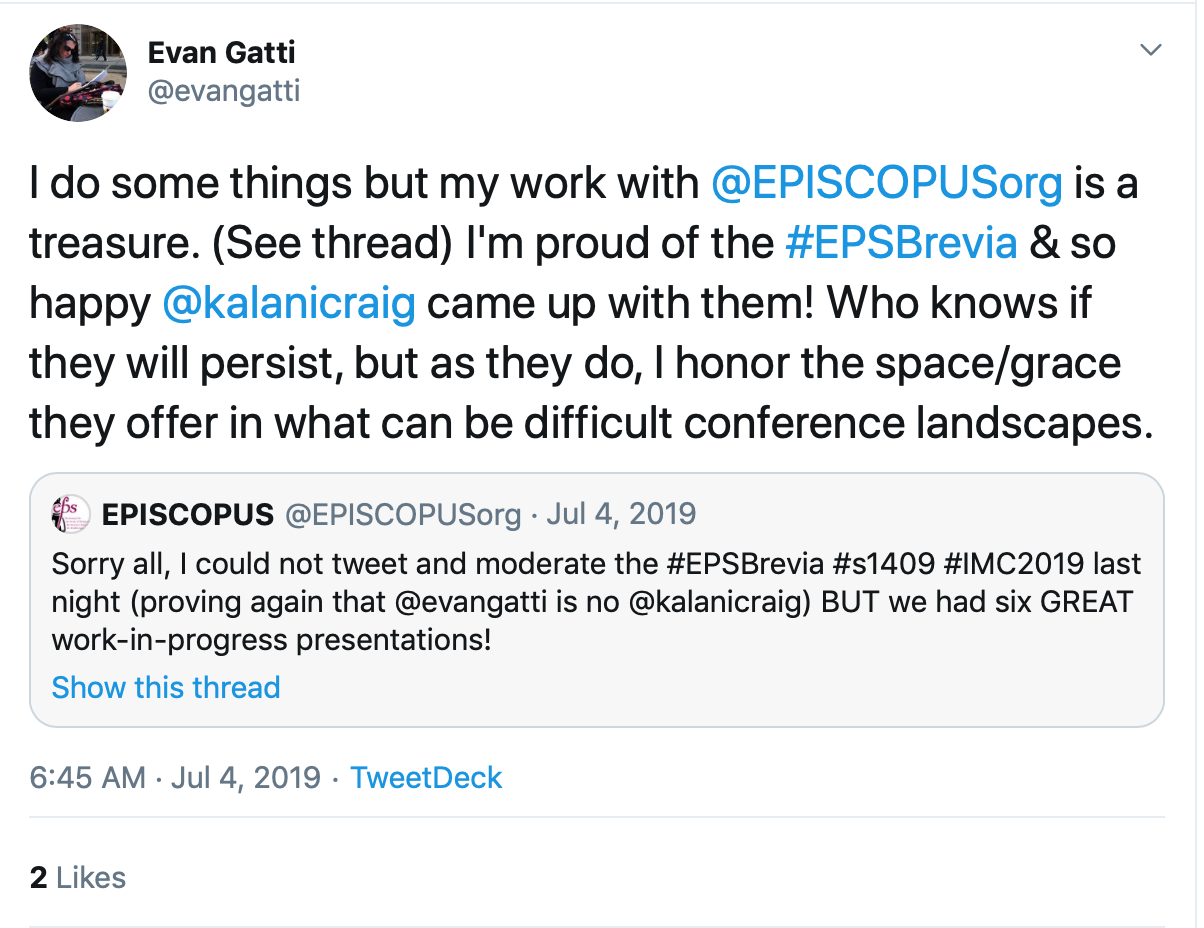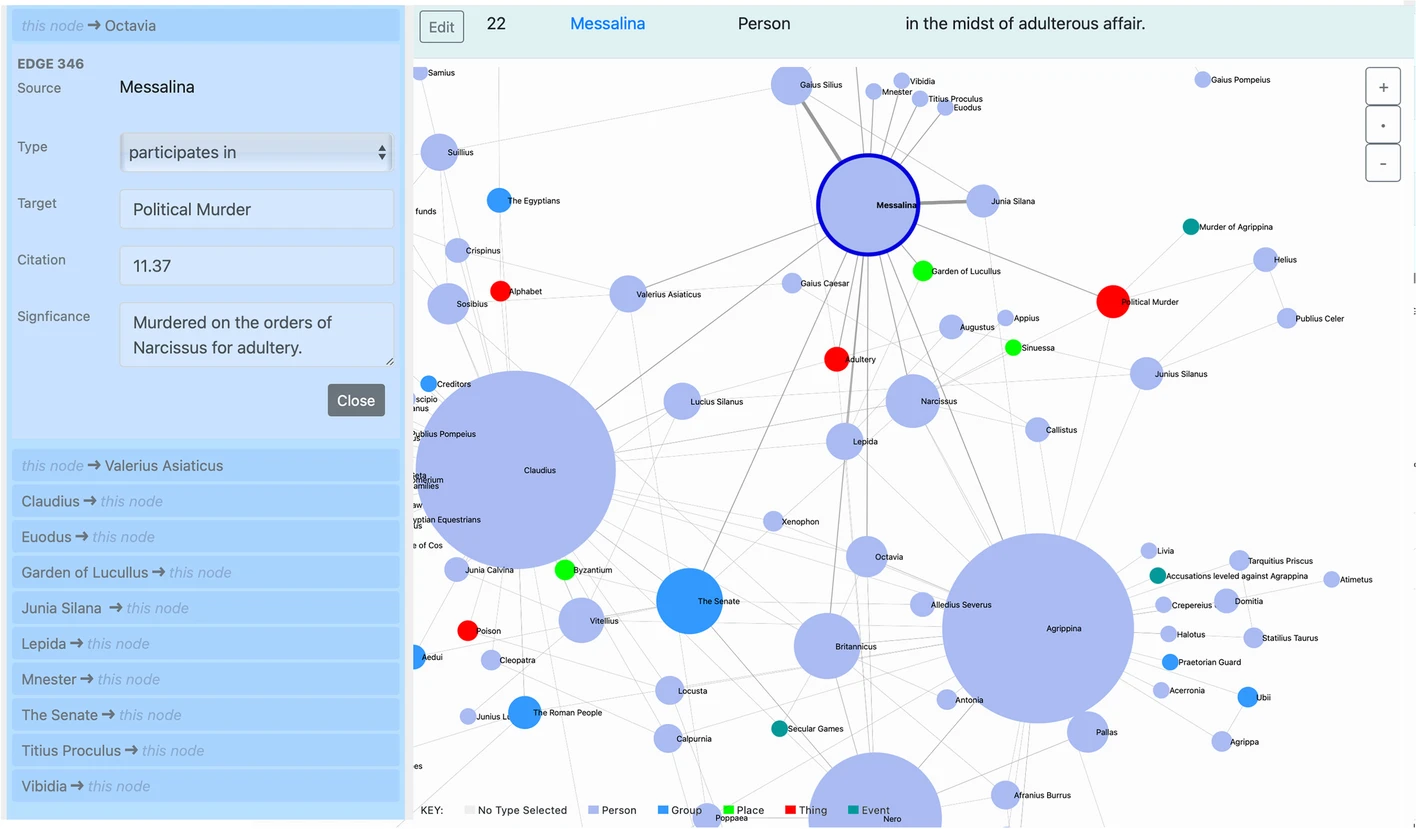The division between my service, teaching, and research is somewhat blurred when it takes the form of professional-development instruction and consulting for faculty and graduate students who have begun to explore digital methods in their own research and in their classrooms. I incorporate lessons from my tool building and digital-history pedagogy research into invited and research-conference talks, structured workshops, and consulting practices. These events help other faculty and graduate students hone their digital-methods approaches in disciplinary-specific ways. Over the years, many of these connections have become fully-fledged research collaborations, a pattern which I hope to continue in the future.
Outside of the integrated teaching-and-research service that takes the form of workshops and consulting, providing digital-methods service to IU Bloomington and to the Department of History means making space, both literally and figuratively, for digital arts and humanities methods at a departmental, campus and national/international level in a variety of service writing and committee environments. By contributing these professional-development and digital-humanities training opportunities, I can help bring perspectives on developing digital-methods expertise from the Department of History and IDAH to a broader audience outside of IU.
The most substantive of my services activities, as the Co-Director of IUB’s Institute for Digital Arts and Humanities, has also been a platform for developing new research projects of my own and identifying research partnerships with other faculty both here at IUB and elsewhere.
Service to the discipline
A number of national and international service projects bring my digital-methods expertise from IU to the history discipline more broadly. Two service activities take particular advantage of the digital-methods nature of my work in history. First, editorial service as a digital-history specialist has provided a venue through which I can help shape the production of scholarly knowledge in both digital history and the historical discipline more broadly. In 2017 was invited to participate in the “Arguing in Digital History Workshop,” a 2-day invitation-only workshop that brought 25 experts in digital history to George Mason University’s Roy Rosenzweig Center for History and New Media (CHNM) to talk about challenges in the field and produce a discipline-leading white paper about digital-history specific processes for producing scholarly knowledge. In 2021, I was invited to serve on the AHR’s editorial board as a digital-history specialist responsible not only for peer-reviewing digital-history scholarship but also for helping the editorial staff expand the journal’s ability to present the arguments made in interactive visualizations. Most recently, I joined the reviews-in-the-classroom team for Reviews in Digital Humanities with the goal of providing a venue for the next generations of digital historians to publish their work. Second, participation in the AHA’s Digital History Working Group has allowed me to provide support for colleagues outside of IU. The working group was tasked with providing guidance in interpreting the AHA’s digital-history evaluation guidelines to scholars, chairs and administrators working on tenure and promotion cases that include digital projects. In 2019, the AHA published a guide focused on communicating these findings to the AHA’s constituents, and I took primary responsibility for writing Project Roles and a Consideration of Process and Product, one of the central pieces of that guide.
A number of outside service projects bring my digital-methods expertise from IU to the history discipline more broadly. Two service activities take particular advantage of the clinical nature of my work in history. First, participation in the AHA’s Digital History Working Group has allowed me to provide support for colleagues outside of IU. The working group was tasked with providing guidance in interpreting the AHA’s digital-history evaluation guidelines to scholars, chairs and administrators working on tenure and promotion cases that include digital projects. We have done so by collecting exemplary digital projects and situating the digital components of those projects in the context of disciplinary contributions. We also connect scholars and administrators with digital historians who can provide support and external letters as part of the review process. In 2019, the AHA published a guide focused on communicating these findings to the AHA’s constituents, and I took primary responsibility for writing Project Roles and a Consideration of Process and Product, one of the central pieces of that guide.
My service to the the field also includes peer-review and peer-contribution work in a number of forums. In 2016 and 2019, I was invited to join review panels for the NEH’s Office of Digital Humanities. I also provided a book review of The Digital Humanities: A Primer for Students and Scholars for The Medieval Review and a review of Bookworm for the Journal of American History (Journal of American History, Volume 105, Issue 1, June 2018, Pages 244–247, https://doi.org/10.1093/jahist/jay139). As an advisory board member for or partner in nationally funded grants that include Always Already Computational: Collections as Data and DataScribe, I can stay connected to changing trends in the world of digital humanities and contribute to the direction in which those trends develop.
Finally, I also offer communications expertise to several national and international academic societies in the realm of medieval studies. One highlight of this experience was bringing Brevia, a panel of short lightning talks designed to make space for nascent scholarship that could be developed in formal conversation at the International Congress on Medieval Studies in Kalamazoo, MI, to Episcopus, an organization that promotes the study of bishops and secular clergy in the Middle Ages. We developed these Brevia as the first step in encouraging open, generous scholarship in a conference setting with the idea that longer papers and articles developed out of Brevia would garner long-term support from Episcopus’ board, for which I have been the communications chair since 2012. We took advantage of this format to offer virtual presentations to presenters whose 2020 papers were postponed to the 2021 conference, and we are currently shifting our society’s priorities to support the long-term development of scholarship by contingent faculty and graduate students into conference panels on medieval bishops and secular clergy in both published and virtual-conference form. I was also the communications chair for the 2021 Medieval Academy of America, which was hosted remotely from the IUB campus.
Service to the public

One of the more exciting service opportunities that presented itself was the chance to help design an exhibit as part of the Mather’s Museum of Art’s 800 Season’s exhibit, an offshoot of IU’s Environmental Change Grand Challenge in partnership with Eric Sandweiss, Theresa Quill, Matt Sieber, Sarah Hatcher and others. Our project revolved around a “kinetic sandbox” that uses the live movement capture of Microsoft’s X-Box platform to track the height of sand in a sandbox and project live topographical outlines, complete with colors, onto the sandbox as the user shifts the sand around into different formations. We wanted exhibit visitors to understand how water shapes the human experience in a local context, so we built two activities that asked visitors to get their hands dirty (or at least sandy) in the service of rebuilding Bloomington in a sandbox. The first provided a map of 1910 Bloomington with only topographical lines and asked visitors to try to recreate that topography in the sand; a reveal map showed them how close their sand-scape was to the reality of Bloomington and asked them where the flooding might happen during heavy rains, with the idea that they would take a better idea of how to read maps out of the exercise. The second map showed them a pre-World-War-II map and asked them to predict where a man-made reservoir now lies by digging out the map and looking at where the kinetic-sandbox projection showed water collecting, with the idea that we could impart some water-engineering understanding to visitors.
Service to IU
Closer to home, support for the digital work done by other faculty and graduate students here at IU has guided my committee and working-group commitments. To that end, I’ve focused on service duties that address the importance of IU’s digital and physical infrastructure in supporting digital methods, so that there is practical support available for faculty who would like to integrate digital methods or digital tools more broadly construed into their teaching and research.
As co-director of the Institute for Digital Arts and Humanities, my service to the University has drawn on the history department’s goals and needs to help other humanities researchers and educators. In addition to fellowship administration and consulting for both faculty and student fellows, I work with my colleague Michelle Dalmau, and our research assistants and office staff, to manage several active speaker series and a weeklong Summer Incubator, which is designed to jumpstart 6 digital-methods research projects each year. In late July of 2020, we completed our third-year review, which is available publicly, and in 2022 alone, center affiliates produced more than 80 fellowships, grants, awards, papers and presentations based on their work with IDAH.
Beyond IDAH, I’ve also made it a mission to find ways to merge the technical needs of digital methods with the broad variety of concerns driven by researchers and teachers across IU’s campus. Work in virtual and physical spaces on campus and system wide, as well as contributions to the college strategic plan, have provided inroads for history to make its needs and presence known campus wide. At an IU-system level, I’ve provided infrastructure-oriented service as a Mosaic Fellow and on the Smart Classroom Working Group. In Bloomington, I’ve served as the faculty representative on the Bloomington Faculty Council Teaching and Learning Spaces Committee (2019-2020, 2021-2022) and on the Bloomington Faculty Council Tech Policy Committee (2019-present). These service commitments have given the Department of History input into the shape of IU’s future classrooms and technology needs across the entire system. The result is a vision of a smart classroom that is flexible enough to support faculty who prefer minimal technology, faculty who do active learning, and faculty who combine active learning with technology. Participation in the 2016-2017 College Strategic Planning Committee as a member of the Facilities and Technology committee documented the IT and computer support needs of College Faculty, our wish for more effective communication of technical and classroom resources, and updated department-by-department considerations for the responsibility-centered management budgeting that drives IU systemwide allocations.
Service to the department
Much of my work for the department clearly ties to teaching and professional digital-history development, or the research that supports those two endeavors. While it may seem like maintaining our department’s web presence is an outlier, redeveloping the department’s web site, it too aligns with these historical considerations. Maintaining it and offering it as a communication platform has given me yet another avenue through which I can make use of my industry skillset to bring the work and tools of a professional historian to bear on public life. I’ve drawn on the research skills of a historian to understand our audience needs and the evidence-based user-interface practices that dominate the world of web design as I tackle these web-based administrative tasks. As a result, many of these administrative service tasks have both professional and personal payoff.
A new-look launch in May of 2016, which dominated the first 8 months of my appointment, took content from the old site and repurposed it in the context of a new design with features that are both better suited to the smartphones on which the bulk of our audience view the site and to making our web presence more widely accessible for viewers with visual impairment. Elements of this redesign were instrumental in helping the campus at large as it moved wholesale to the new platform in which I developed the site. Notably, The College of Arts & Sciences used elements from the course listings, faculty profiles, publication listings and newsletter formats that I developed as templates for a College-wide rollout of in other departments. A full content update of the web site in Sept 2016, largely focused on undergraduate and graduate needs, included newly written copy across the entirety of the site and a variety of new photos to accompany the copy (some of which I took). The notable changes included mechanisms for faculty to do simple content updates to their own faculty pages, a sophisticated course-listing page that helps with undergraduate-registration marketing, and a graduate student listing that will help us use up-to-date graduate profiles for intellectual and recruiting purposes.
In 2017, I began to think about how the web site might serve as an administrative center to help us coordinate course offerings, manage our day-to-day teaching needs, and help students navigate the university’s policies and procedures. The transfer of some of the forms we use for administrative purposes—course requests, faculty voting, undergraduate surveys, graduate student admissions ratings, etc.—from Word to online form began in late 2018. This process accelerated during the Spring 2020 COVID-19 closure. Because we had familiarized our faculty and staff with the process, it was much easier to manage these faculty governance items remotely. I hope that refining these processes when we’re not in a time crunch and stressed by a pandemic will help further reduce administrative load for faculty as we plan and offer courses, as well as limiting the instances in which our administrative staff have to do a second round of redundant data entry.
In 2019 and 2020, the foundation we built as a department to handle simple administrative tasks gave us a platform to speak out on issues that face history departments everywhere. First, in the process of reformatting our alumni newsletter in summer and fall of 2019, I wrote several alumni features on graduates of IU’s program whose careers offer a vision of how the history Ph.D. serves our alumni working outside of the academy. These features brought visibility to the department’s focus on the many career paths open to history PhDs, which we have pursued as a member of the Association of American Universities’ PhD Education Initiative; they also provided publicity for alumni from our department whose careers have taken them to a variety of positions not often featured in alumni newsletters, providing both a point of pride for our existing alumni and a set of role models for our current graduate students. When we were called on to handle a semester of remote learning, the web site celebrated our graduates and their paths to the practice of history.
Since May of 2016, more than 189,000 viewers have come to the Department of History’s web site to find out more about the contributions our students, faculty and staff make here at IU and beyond. More than 50,000 people have learned about our faculty research specialities and more than 14,000 undergraduates have depended on our course listings to make their enrollment choices. As our department’s major communal public platform, the web site played a vital role as we tackled the world of remote communication in Spring of 2020. Department-wide efforts to promote research, archival work and student celebrations included a virtual Spring Symposium for our 2020 History Honors students, and a virtual “stage” for our graduates to walk across.

